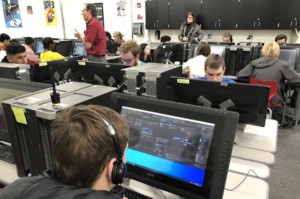How School Districts Work

Co-authored by Cathy Mincberg, Center for Reform of School Systems, and Tom Vander Ark
School districts have a theory of action but don’t or can’t express exactly what it is. Naming the theories in use is the first step to designing a system of schools that serves a community well.
We recently led a school board retreat where we discussed the theories in use across North America. They range from highly decentralized systems with diverse schools to updates to what David Tyack called The One Best System.
One Best System. Historically, teachers were allowed to close their doors and teach what and how they chose while boards and superintendents had decision authority over most school operations such as the budget, schedules, teacher selection, and compensation. This odd “One Best System” was loose on the control of the curriculum (the core of schooling) and tightly controlled everything else. (Red=district control, yellow=school control.)
Managed Instruction. Once districts and states began to track student achievement and make poor performance visible, districts began to tightly control what was taught (managed curriculum) and in some cases tightly control how it was taught (managed instruction/pedagogy). This ensured that all students were taught the same content but also created more of a compliance culture. Teachers complained that it stifled teacher initiative and was bad for students yet the large urban districts making the most student achievement progress used a managed instruction approach.
Some smaller systems sharing a common curriculum don’t stifle teacher leadership. The enterprise approach in Mooresville (i.e., shared pedagogy, curriculum, systems, and devices) is featured in the Blended Learning Implementation Guide and superintendent Mark Edward’s new book, Thank You For Your Leadership.
Emerging potential for personalized and competency-based learning learning changes many of the policies and practices of managed curriculum/instruction (e.g., individual pacing rather than progressing in age cohorts).
Performance Empowerment. some communities (most high functioning or disaster recovery) experimented with full decentralized system where decision-making authority regarding curriculum and operations was granted to individual schools. In exchange, schools are held accountable for results.
The rationale for these decentralized systems is that principals and teachers can’t be held accountable for student achievement if they do not have significant control over their work–responsibility and authority go together.
Edmonton Alberta was among the first and most widely publicized examples of decentralized districts. The New Orleans recovery created a fully decentralized system.
Many superintendents tried this in the 1990s and quickly found that schools didn’t know what to do or how to do it. School leaders had been so eviscerated by a compliance culture, that the skills to facilitate a coherent instructional mission and build the related structures and systems didn’t exist.
Fully decentralized systems don’t provide any continuity for mobile students; they don’t intervene quickly in failing schools; and they assume school communities will respond quickly to demands for performance and the freedom of empowerment to produce excellence (which doesn’t always take place).
Fulton County Georgia has supported school empowerment by identifying and training teacher leaders, supporting new school models, and backing improved access to technology.
Under Chancellor Joel Klein, New York City became an empowerment district with a high degree of autonomy at the school level, but the NYC DOE actively closed and replaced low performing schools.
Denver Public Schools recently reaffirmed its support for a decentralized systems. They continue to discuss how and when to intervene in struggling schools.
Managed Performance/Empowerment. To address the shortcomings of fully centralized and fully decentralized options a growing number of districts have developed a hybrid approach called managed performance/empowerment or tiered support/earned autonomy. High performing school are granted greater flexibility; low-performing schools are tightly managed.
These systems can be difficult to design and manage, requiring multiple management approaches simultaneously and require nimbleness and a systems infrastructure to move schools from one tier of autonomy to another depending on performance. Treating schools differently can raise concerns about fairness.
Steve Adamoski piloted this approach in Cincinnati in the 90s. Boston Public Schools used managed performance/empowerment to become the best urban district in the country in the last decade.
Hybrids. Most urban areas exhibit a hybrid approach. School districts and public charter schools collaborate and coordinate offerings in Compact Cities. Washington DC is half managed performance and half a decentralized portfolio of charter schools. Las Vegas and El Paso are managed performance systems with a district operated layer of choice options.
School boards and superintendents should agree on a theory of action. Boards should incorporate it into district policy. District leaders should operationalize it into staffing, budgeting, and school support strategies. It starts with naming the theories in use.
For more see











0 Comments
Leave a Comment
Your email address will not be published. All fields are required.